| |
All winds blow to kashgar
Preface
Chapter 1. RED MOUNTAIN
Chapter 2. VIA TIGER JAWS
Chapter 3. THE KINGDOM OF SANDS AND FOG
Chapter 4. WITH THE FAIR WIND
Chapter 5. THE ONLY AND UNIQUE KASHGAR
Chapter 6. KASHGARIAN MONDAYS
chapter 3. the kingdom of sands and fog
It was not a long way to Korla, but the dull weather next day was unpleasantly pressing down on our psyche and spoilt the mood. Numerous small metallurgical plants spreading chocking stench around added fuel to the fire. The Aktag Mountains were a small but quite unexpected obstacle, through which lay the only way to Korla. We had to become pedestrians again and slowly pushed the bikes upward. But the descent, as usual, was rapid and captivating. When I saw Korla from the pass, I was greatly surprised at such a large number of high modern buildings which were abundant in the town center. It was in this town which turned out to be rather large, that we planned to stay for 2 days to have a rest after the mountains and tidy ourselves up.
 |
Memorial complex in Korla
|
Preliminary search for a not expensive hotel did not come to any result: the prices in the hotels we could find differed greatly from what we thought of normal prices in China. In search of a place to stay at night we were moving along the river. It was there that we came across the cafe with the name absolutely unreal for Korla, written in Russian: 'êàôå ìîðîæåíîå Íàòàøà ' (ice-cream cafe Natasha). We definitely hoped to find a Russian-speaking person in that place who would advise us a middle-priced hotel to put up at. There were no Russians in the cafe, but we saw Kazakhstani beverages instead. This suggested that the name of the cafe was not accidental. There was also an Uighur guy there who spoke rather good English.
Meeting Dilshad (that was his name) was a fortune for us. It is actually very difficult to find a moderately priced hotel in a Chinese city without knowing the Chinese, or Uighur language (as in case with Xinjiang), because an English inscription ‘HOTEL’ would usually represent establishments with impressive prices (with few exceptions). That is why getting acquainted with natives is a good way to find a hotel in a place you would never go to in search of accommodation with the prices considerably lower than in that with the English-speaking staff. This happened to us – for two days we became masters of a room in the very center of the city for the price that foreign tourists are just dreaming to have.
Dilshad turned out to be a very significant person. His lavish words that they Muslims must not eat Chinese food, his love to everything American (education, basketball, English) combined with seemingly contrast to the American lifestyle strict Muslim view of moral; his serious attitude to health and negative attitude to what influences it badly, composed the general impression of the main line inherent in modern Uighur generation’s upbringing. Dilshad who was originally from Korla told us that he was studying in Beijing at the department of law but was cherishing a plan to study in the USA.
Thanks to Dilshad we could taste Dungan cuisine. I actually gained an impression that the Dungans (the Hui nationality) are more prevalent in Korla than for example in Urumqi. We learnt from Dilshad an interesting fact concerning cafes: any Muslim cafe, be it an Uighur, a Dungan or any other one, can be recognized from a very typical signboard, which pictures first of all the dishes cooked in this place (5-6 most popular), and the contour or a stylized picture or just a photo of a mosque. This is in general very comfortable when looking for something concrete. Whereas Dilshad entertained love to America, our next passing but well-remembered acquaintance was obviously taught quite the contrary. We also met him due to the ice-cream cafe ‘Natasha’. When Sanya was trying to take photo of that uncommon in Korla place, he was disturbed by a Chinese passing by, who eyed at the signboard and told in distinct Russian, ‘There’s a mistake there. It should be cafe OF ice-cream but not ice-cream cafe’. We decided not to dispute about set phrases in Russian but to ask the passer-by where he mastered Russian. This man who was about fifty, turned out to learn the language at school. And the phrase he remembered best was ‘down with the American imperialism!’, which he declaimed us not a single time, trying to demonstrate his knowledge of Russian.
The Quay has been one of the sights in Korla for many years. As early as in the 19-th century European travelers wrote about the river Konchedarya which flew from lake Bagrashkel (modern name Bosten) and in which all Korla inhabitants enjoyed bathing. Nowadays the river crossing the town center cannot boast of its purity so that people could bathe in it (they use lake Bosten for that purpose) but the Quay is definitely bearing the palm as the most popular walking place among the citizens. Stuffed between concrete banks, this river is attractively decorated with numerous cascades forming lots of mini-waterfalls along the river, which makes the impression of the stream more idyllic and even somewhat magic at night. The Quay is also a popular place to hold various mass cultural actions. Thus, on our second day we witnessed children’s folk dance festival, where we got an opportunity to get acquainted with national costumes of the peoples inhabiting Xinjiang. After descending from the mountains before Korla we saw only patches of desert, now we had to face the desert personally as it were. Our way led from Korla westwards along G314 highway, across the Taklamakan desert to ancient agricultural oases Kuqa and Aksu.
‘The Taklamakan desert’ - you could hear something threatening in this phrase. Indeed, the name of the desert is not accidental, according to one version meaning ‘if you go there you will never come back’. The biggest desert of Central Asia, what was it like? It was very interesting for us to know what it feels like. The first impression was the fog, the mist better to say, coming from all the parts of the horizon and limiting our visibility to three-five kilometers. Very often the road going upward seems the way to heaven. The grey sky (as if it were littered by constant dust-storms) creates an impression of some perpetual and never ending depression. But this is occasional; sometimes the sun shines brightly and literally makes everything burning hot. And the only escape is numerous bridges under which streams coming from the mountains purl in spring and necessary for the desert coolness and shadow are kept in summer. We used to have a rest hiding under such bridges in the afternoon heat.
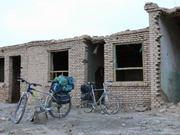 |
In slums of Luntai |
The second impression was that the desert is not so lifeless. For many years the man has conquered every inch of land from Taklamakan, turning it to blossoming gardens. Numerous oases which cover vast space with green fields stretching many kilometers along the road have become the main reason because our ‘vitamin diet’ that began during the descent was not going to be over. Local peaches, watermelons, grapes and other fruits can be deservedly considered best in their way. There was also an unpleasant impression. Chinese industry widely develops the territory of Taklamakan which is proved by numerous petroleum gas flares located everywhere, as well as other plants and mines. After Luntai and close to Kuqa we even had to spend nights near some of these plants, which surely did not add any charm to the desert in our opinion.
I should have never thought that the wind could have such an influence on the speed you are moving with, which in its turn affects your mood. For several days the wind was blowing in all possible directions excluding the favorable one. It often turned from gentle to moderate, with blasts which literally threw us out the road or under the wheels of the cars driving by.
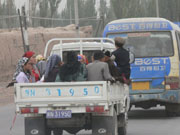 |
Features of national carrying
|
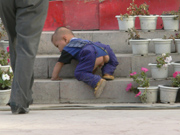 |
Features of children's clothes
|
When you are pedaling the whole day and can see only the road and transports moving on it, you begin to pay attention to the latter, for the road is always the same (with a few exceptions): ideal asphalt pavement with a yellow center line and precisely measured kilometer stones and 100-meter marks on the border. But the cars and other means of transportation strike you by their diversity and the diversity of what they are carrying. We have seen a lot of variants: the bullock-cart is used for transporting people, whereas tractors with trailers or three-wheel cars with bodies carrying large families with many children are obviously a local invention. Those mechanisms are rattling so loudly that they seem to live their last hundred meters, but they are moving quickly with the load incompatible with their size and shaking the way you think unintentionally of the consequences of their falling on the cars passing by. We arrived at the town of Kuqa early in the morning, and the first problem we had to solve was hearty and delicious breakfast that certainly improved the mood for the whole day that followed. The place for having breakfast we found in a new part of the town in its big trade quarter. Besides, the cooks in that cafe where we tasted pilaw and tandoori samsa deserve to be described individually.
When rather fat (as a cook should be) Osman got onto my bicycle which was far from easy to steer because of huge bags on the carrier, I thought that it was curtains for my bicycle and Osman as well. But he easily pedaled and made a lap of honour round the square. Another cook, Abdrakhman, made us happy by his little knowledge of Russian. When we got to the top of the tower elevating amidst the square and began taking photos of the surroundings, our funny cooks performed a scene like that of Ali-Baba and the forty thieves. Kuqa definitely existed in the first millennium B.C. and many blocks of buildings stand in their integrity even nowadays. The life of the old town with its narrow sinuous streets where one can be observed life of natives through the doors wide open in the inner yard was agitated for 20 minutes, when we organized a real bicycle race aimed mainly at finding a good place to take photos from without local idlers who got on our nerves by their spontaneity and curiosity.
 |
Ablution |
Besides numerous fruits and vegetables they cultivate cotton in agricultural oases surrounding Kuqa. We had an opportunity to watch the procedure of its picking when in the afternoon we settled ourselves to rest on the edge of a large field. The girls timidly looked at the two strangers and hampered taking normal photos in every way. But, despite this, we managed to get a few good pictures. The town of Xinhe remained in our memory because we could wash ourselves there, besides, thanks to the same reason (in my opinion) we were remembered in the town mentioned as well. Passing one of the streets in the noon, when the heat was at its zenith, we saw water spurt of a tap, the water used for irrigation. The man, whose truck was standing near this ‘oasis’, was washing and shaving with the water from the tap. We decided that we could do the same as well. The show of the two pale-faced men washing hair with the water from the tap gathered a lot of people immediately. The number of spectators broke all records possible. When we left, accompanied by a crowd of young bikers who decided to go to Kashgar, too, Sanya and I joked that very day that tap would be considered a sacred place of Xinhe and the water from it healing.
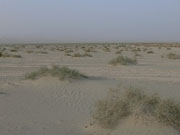 |
|
Oases were over after Xinhe, and the next day we cycled across the uninhabited desert up to the noon. At a dinner-time we noticed a building on the right, which obviously served as a motel, restaurant and shop for those who were thrown by fate to these severe and seemingly inhospitable places. When we set at a table and ordered some beer, we arouse genuine interest of all the staff and the customers in this institution, who literally began to walk around us in circles. This place situated almost ‘in the middle of nowhere’ and its customers were strongly associated with the movie ‘From Dusk Till Dawn’, but in a quieter and lighter variant. This impression was intensified by the doors wide open, through which one could see the dust muddling and listen to the wind roaring. Finally, the owner of this motel – U Tua – set at our table. In fact, we could understand that he was the owner of the institution when, after we had spent an hour at the same table with him eating and drinking and communicating in a strange language (he spoke Chinese, we spoke Russian), we left without paying money because everything was at the expense of the institution, as it is called. We were also proposed to spend a night in this motel at the expense of the motel, moreover, not alone but with the girls twisting round us (or at least we understood it this way). But we made a gesture showing we had to cycle a lot and left this hospitable place.
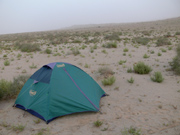 |
Our home - Coleman Nevada
|
The local infrastructure is designed not for tourists who are uncommon here, but for numerous truckers and people going by buses between Kashgar and Urumqi. This infrastructure is however well developed, and this fact together with numerous green oases quickly gave birth to our illusion that water could be bought or taken almost every few kilometers. Moreover, the map we had was scandalously wrong, and it did not have many villages existing in reality. But once this map turned right. One after another we passed the bridges across dozens of dried up small and big, according to their beds, rivers. There was not a hint of water somewhere around. We cycled until the dark but did not find any place to take water from. That evening we shared half a liter of water remaining for supper and breakfast. That we understood the map could be correct afterwards oppressed us greatly, because it meant we would have to cycle about 90 kilometers to reach the nearest civilization. The next morning we drank the rest of water and continued our cheerless way. How glad we were when after 20 kilometers odd we saw contours of a refuelling show on the horizon.
Having drunk as much as our organisms could store, we set off for Aksu very satisfied. And soon we could not even believe that half a day ago we were burning with thirst in a lonely hostile desert. Green oases forestalling the town pleased us with their shades of trees, cool water and green fields. At about five in the evening we were entering Aksu – the town on the White river.
|



